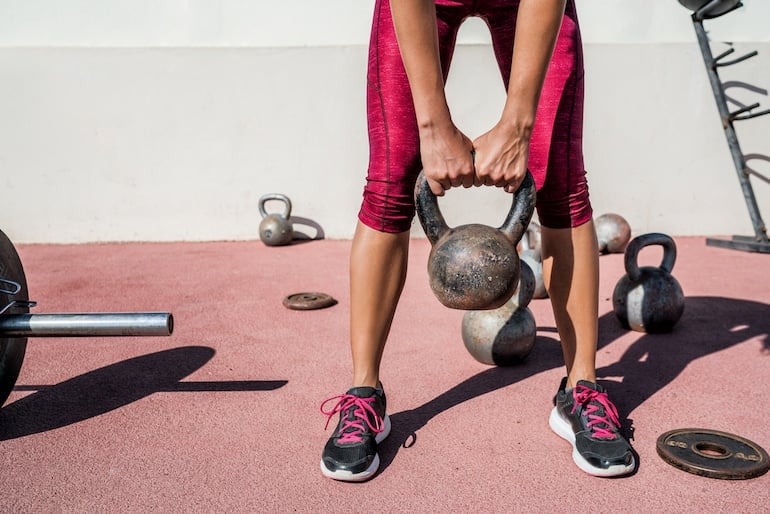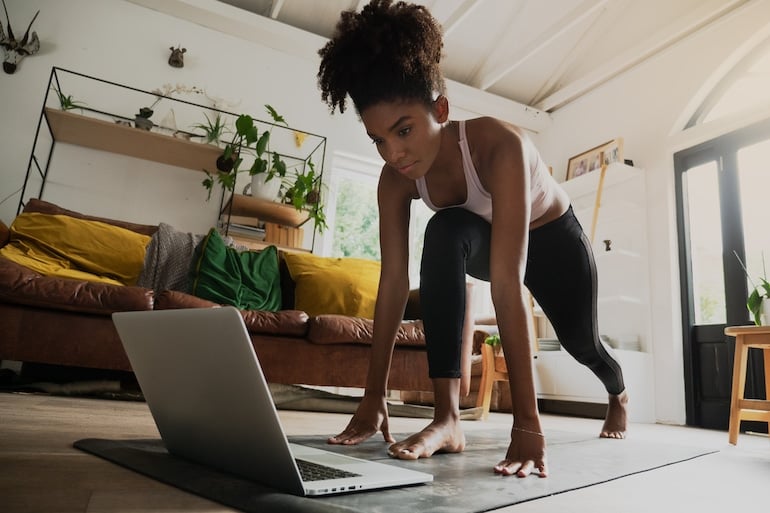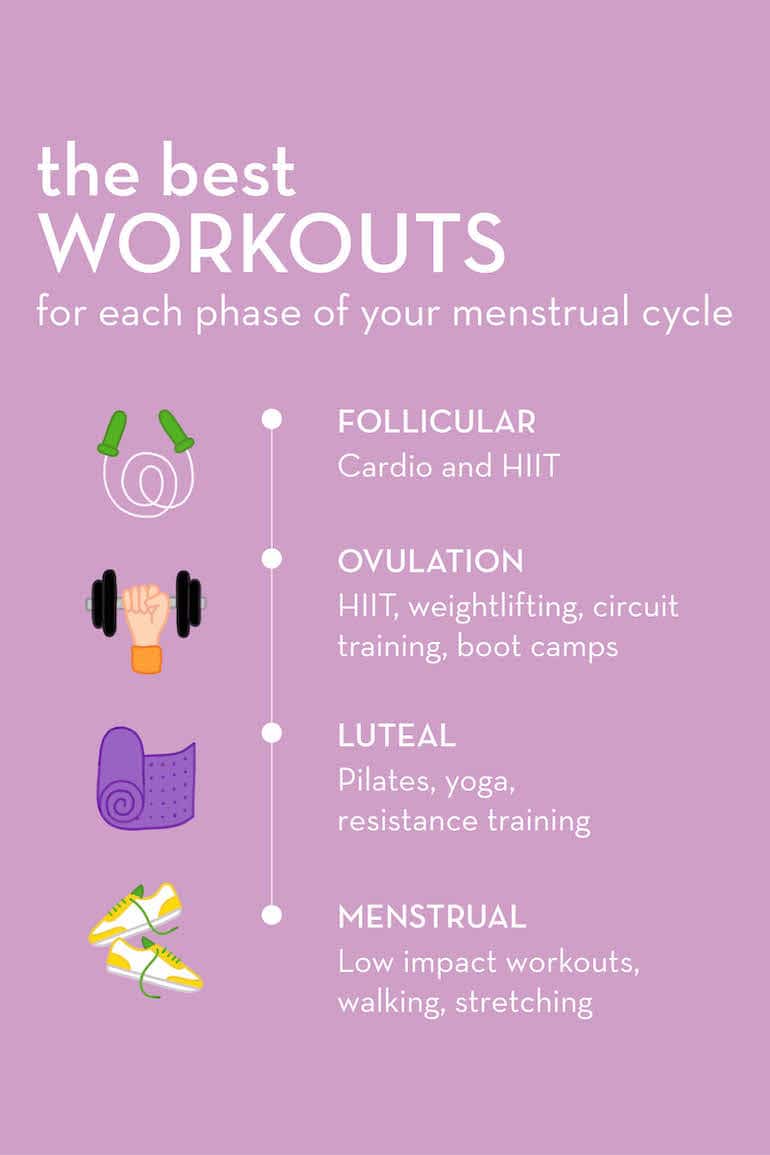Confidently Plan Your Workouts According To Your Cycle

Want to get more out of your workouts while nurturing your hormones? Your menstrual cycle may hold the key. Hormone expert Dee Davidson shares how cycle -syncing exercise makes sense.
There’s a lot of confusing information surrounding working out and your period. Workout? Rest? Does it matter? For some people, the thought of working out while on their period is literally a joke. For others, exercise can help ease uncomfortable symptoms like cramps or bloating. Or maybe you don’t think twice about hitting the gym or live-streaming your favorite class while on your period. No matter what symptoms you experience during your cycle, you can benefit from cycle- syncing exercise.
Below, Dee Davidson (Certified Hormone Health Coach) shares what you need to know about cycle syncing your workouts and how to do it for the best results.
WHAT IS CYCLE- SYNCING?
The idea behind cycle- syncing is that by “syncing” certain activities, nutrition, supplements, or workouts to align with the cycle phases, you can optimize your hormones and feel better throughout the month. Some people use cycle- syncing to guide everything from what they eat to how they work.
It turns out that having an infradian rhythm, also known as our monthly cycle, causes changes in our metabolism, brain, stress, and other systems. Simply stated, we’re not the same throughout the 4 phases of our menstrual cycle. We have different calorie, fitness, and nutrient needs depending on which phase we are in. Makes sense, right? Ever feel ravenous right before your period?
Your hormones change throughout your cycle. There are specific ways you can adapt to your cycle and hormone pattern instead of working against your hormones. Again there are many ways you can do this, but when it comes to exercise specifically, cycle- syncing can help you feel more in tune with your body and workouts and may even help you get better results.

MENSTRUAL CYCLE PHASES
Before diving into how to cycle- sync your workouts, let’s do a refresher on each menstrual cycle phase and what’s happening in your body during each stage of a 28-day cycle.
Hormones are the body’s most sensitive signals and control so much more than we think. During your menstrual cycle, your body is undergoes hormonal shifts characterized by four distinct phases: menstrual, follicular, ovulatory, and luteal.
PHASE 1: FOLLICULAR (THE 7 TO 10 DAYS AFTER YOUR PERIOD)
In the follicular phase of your cycle, your estrogen hormone rises which is when the lining of your uterus grows (and this lining is what’s shed during your period bleed). During this phase, all hormones start low, and estrogen peaks before ovulation. This change in hormones has you feeling more alert and energized,
PHASE 2: OVULATORY (AROUND DAY 14 OR IN THE MIDDLE OF YOUR CYCLE)
The ovulation phase is when your body prepares to release an egg, which happens when the luteinizing hormone (LH) triggers the ovaries to release an egg. There’s a rise in hormones here, and energy levels rise too. This phase usually lasts 24 hours.
PHASE 3: LUTEAL (THE 10 TO 14 DAYS BETWEEN OVULATION AND YOUR PERIOD)
The phase when you’re most likely to experience PMS is during the luteal phase, which is the phase that leads up to your period. Hormones begin to dip during this phase as you near menstruation. As hormones estrogen and progesterone drop, some women can experience premenstrual symptoms like fatigue, headache, and cramps (although other symptoms outside this list can happen too.)
PHASE 4: MENSTRUAL (THE 3 TO 7 DAYS OF YOUR PERIOD)
The menstrual phase, or the phase of your cycle that begins when your period starts, is the final stage of your cycle. Progesterone and estrogen are at their lowest levels during this phase, taking energy down.
YOUR MENSTRUAL CYCLE AND EXERCISE
How can you use these hormonal shifts throughout your cycle to your benefit? One of the main goals of cycle syncing is to match your energy levels to your workouts, which is largely dictated by your hormones.
The most important thing about workouts, and your cycle is that you do the proper intensity of the workout to match the phase you’re in. This will significantly help balance your hormones and prevent any future hormonal and health conditions, and this is due to keeping cortisol, insulin, and progesterone levels balanced. Many women force exercise when their body is asking for rest or gentle movement. This type of behavior may hurt your hormones.
During your luteal phase or menstrual phase, when your hormones drop, you may feel drained more easily. During your ovulation phase, when your hormones are rising and you tend to have more energy, you may be able to hit a higher level of intensity in your workouts. These changes can dictate how you feel when you exercise, but also how you perform.
THE BEST EXERCISES TO DO IN EACH PHASE OF YOUR CYCLE
FOLLICULAR PHASE: CARDIO AND HIIT
In the first half of a woman’s cycle (follicular and ovulatory), due to lower resting cortisol levels, it is best to do cardio and HIIT workouts. This will result in lean muscle gain and using stored fat as fuel. Since your hormones may help you feel more alert and energized during this phase, Coach Dee suggests taking advantage of doing more intense workouts that rev your heart rate as your body and hormones are prime to handle this type of exercise. She has designed a simple 12-week workout app to help you with your HIIT workouts.
OVULATORY PHASE: HIGHER- INTENSITY WORKOUTS
(HIIT, weightlifting, circuit training, boot camps)

As your hormones rise with ovulation, you’ll feel more energized and likely more up for higher- intensity workouts and cardio. During ovulation, you can continue HIIT, weightlifting, or sweaty, intense boot camp style workouts since your hormones are primed to help you power through these high-energy workouts.
LUTEAL PHASE: SLOWER PACED, STRENGTH BUILDING FOCUSED WORKOUTS
(Pilates, yoga, strength training)

Dee recommends avoiding higher- intensity cardio workouts in the luteal phase since some studies have shown that the muscles respond better to this type of training in the earlier phases of the cycle. Studies show that if you keep doing the cardio/HIIT intensity level of workouts after ovulation, in the second half of your cycle, you will actually turn on fat storage and muscle wasting. This is why Dee recommends focusing on slower-paced strength workouts during this time that aren’t cardio-intense.
MENSTRUAL PHASE: LOW IMPACT, EASY WORKOUTS
(Walking and stretching)

The menstrual phase is the time to slow your workouts and move in a way that isn’t too taxing on your body and hormones. (And maybe you’ve intuitively been doing this, kudos!) You may feel extra drained while on your period, so this is your excuse to take it easy and listen to your body. Walking, stretching, and other gentle forms of movement are all fair game. 
CAN EXERCISE HELP WITH PMS?
Besides targeting inflammation and boosting circulation. Dee says that cycle- syncing your workouts can help reduce PMS since it helps to support and balance your hormones. According to Dee, hormone imbalances contribute to PMS, so anything you do to balance them (including exercising strategically with your hormone patterns) can help alleviate PMS symptoms. You can also support healthy hormone balance and eases PMS symptoms like cramps, mood swings, and irritability by understanding your internal imbalances. How? Lab testing can help you reveal where underlying hormone imbalances are being triggered.
Join The CLY Confidence Club
Receive weekly tips to boost your self confidence with lifestyle tips, motivation, and inspiration from Coach Dee!
We hate SPAM. We will never sell your information, for any reason.

